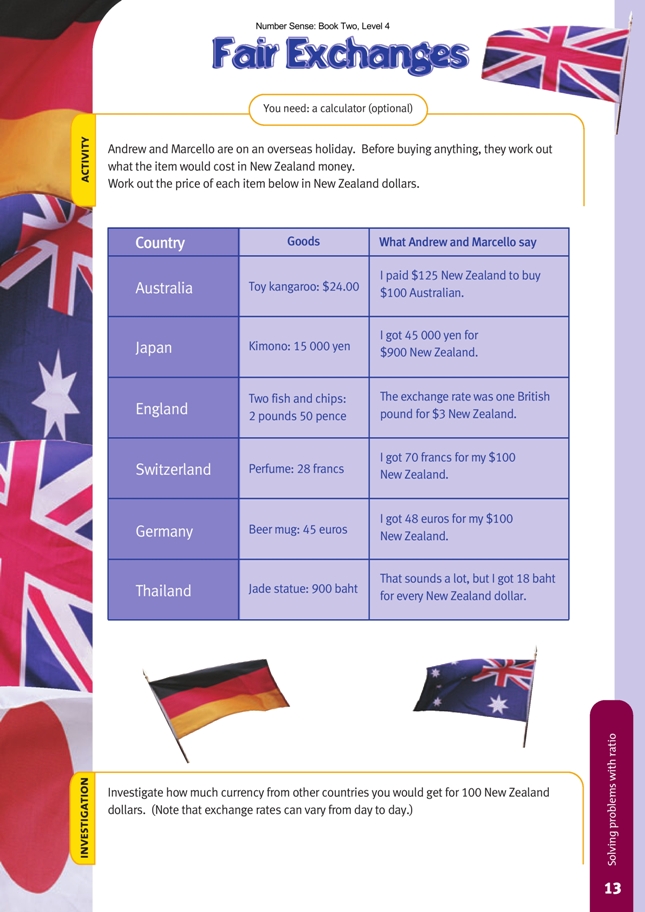This is a level 5 number activity from the Figure It Out series. It relates to Stage 8 of the Number Framework.
A PDF of the student activity is included.
Click on the image to enlarge it. Click again to close. Download PDF (612 KB)
solve problems involving currency exhange rates
A calculator (optional)
Converting overseas currency to New Zealand dollars can be tricky, but it is essential if you are overseas and want to work out whether what looks like a bargain is really a good buy.
Several strategies can be used to work out the prices in this activity. One approach is to make use of ratios. For example, question 1 can be thought of as “100/125 is the same as 24/” or alternatively as “125/100 is the same as /24”. That is, you need to find out what number is so that 125/100 and /24 are the same. Whichever
way it is written, the question is: What does 100 have to be multiplied by to become 125? This can be done by dividing 125 by 100 (it is 1.25, and no calculator is needed for this initial step). To maintain the same ratio, the 24 should now also be multiplied by 1.25. The students should recognise this as 11/4 and be able
calculate mentally that the product is 30 (that is, 1 lot of 24, plus 1/4 of 24). If not, then they can simply use their calculator to work out 24 x 1.25.
Another approach is to calculate the value of 1 unit of foreign currency in New Zealand dollars and then multiply this amount by the foreign currency price. To find the value of 1 unit of foreign currency in New Zealand dollars, divide the New Zealand dollar amount by the foreign currency equivalent. For example,
question 2 states that 45 000 yen is equivalent to NZ $900. A calculator quickly shows that 900 ÷ 45 000 = 0.02. So 1 yen = NZ$0.02 (2 cents). For the kimono, multiplying 0.02 by 15 000 (the price in yen) gives a price of NZ$300.
Question 2 can also be done in a similar way to question 1. It can be set out as follows: 45 000/900 is the same as 15 000/ . In this case, it may be easier to use the horizontal approach and ask “What does 45 000 have to be divided by to get 15 000?” The answer is 3. It therefore follows that the 900 also has to be divided
by 3. This results in 300. It would have been possible to work vertically and ask “What does 45 000 have to be divided by to get 900?” The answer is 50. Dividing the 15 000 by 50 to maintain the ratio again gives 300.
In question 3, the students will probably see that the British pound is worth three times the New Zealand dollar, so it is a matter of multiplying the 2 pounds 50 pence by 3. The result is $7.50. This could also be set out as a ratio, that is, 1/3 : 2 pounds 50 pence/ .
Questions 4, 5, and 6 can be tackled in similar fashion.
The investigation into how much NZ$100 would be worth in other currencies depends on two things. Firstly, it requires information about exchange rates. The students may be able to suggest that these can be obtained from banks, newspapers, television news programmes, or the Internet. Secondly, it requires the use of ratios
once more. For example, if NZ$1 is worth 86 cents in Australian currency (A$0.86), then the ratio will be 1/0.86 : 100/ . The 1 has to be multiplied by 100 to get 100 on the top line, so the 0.86 on the bottom also has to be multiplied by 100 to maintain the ratio. That results in A$86. (Note that the exchange rate in question 1 is based on the New Zealand dollar being worth 80 Australian cents. Mathematically, 0.8 : 1.0 is in the same ratio as 1.0 : 1.25 or 100 : 125).
The students may notice that banks quote both a “buy” and a “sell” rate for foreign currency. This reflects bank practice of selling a unit of foreign currency for more than they paid for it.
Answers to Activity
1. $24 Australian equals NZ$30.00.
2. 15 000 yen equals NZ$300.
3. £2.50 equals NZ$7.50.
4. 28 francs equals NZ$40.
5. 45 euros equals NZ$93.75.
6. 900 baht equals NZ$50.
Investigation
Amounts will vary depending on the exchange rate at the time.
